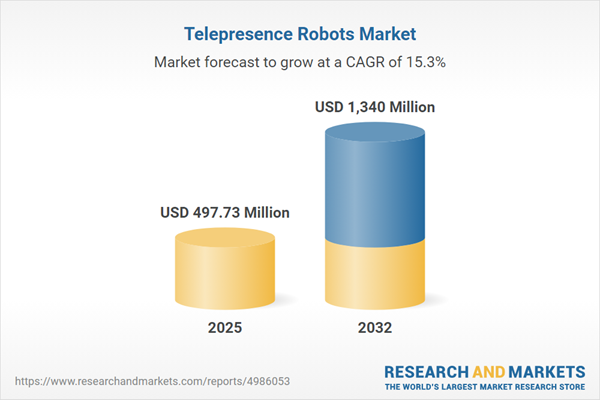Speak directly to the analyst to clarify any post sales queries you may have.
The telepresence robots market is rapidly evolving as enterprises embrace digital transformation to support distributed teams, enhance collaboration, and sustain secure communication across operations. As global workforces become more dispersed, telepresence robots are emerging as vital tools for executive visibility and operational consistency, supporting agile decision-making in dynamic business environments.
Telepresence Robots Market Snapshot
The global telepresence robots market is gaining momentum, entering a significant growth phase as organizations seek flexible, digital-first strategies. In 2024, the market value stands at USD 430.50 million and is projected to reach USD 497.73 million by 2025, driven by a compound annual growth rate of 15.28%. This rise highlights a clear shift among enterprises toward integrating advanced remote collaboration solutions, allowing teams to bridge geographic gaps, enhance executive participation, and align with evolving operational priorities. Senior decision-makers increasingly leverage telepresence robots to unify global teams and strengthen their ability to adapt as business needs shift.
Scope & Segmentation of the Telepresence Robots Market
- Deployment Formats: Aerial robots offer organizations real-time monitoring for expansive or multi-level facilities. Wheeled and track-based models provide mobility in reconfigurable or changing workspaces to meet diverse operational requirements.
- Robot Types: Autonomous telepresence units are designed to streamline repetitive tasks and maintain uninterrupted workflows, while teleoperated robots enable swift remote intervention and operational flexibility. Hybrid models combine elements of user control with automation, delivering adaptability in dynamic environments.
- Component Segments: High-performance hardware enhances reliability, navigation software facilitates integration with existing digital infrastructures, and comprehensive support services—from deployment to maintenance—help ensure productivity and reduce operational downtime.
- End Users: Large enterprises prefer standardized processes and global team integration for transparency and consistent operations. Small and mid-sized organizations opt for scalable, modular solutions that support growth and manage risks associated with new technologies.
- Regional Markets: The Americas and Asia-Pacific lead market expansion, benefiting from robust digital infrastructure and adaptable regulatory frameworks, while accommodating diverse local requirements and complex operational models.
- Key Companies: Leading providers such as Double Robotics, Suitable Technologies, Ava Robotics, OhmniLabs, Vecna Robotics, Temi USA, No Isolation, Giraff Technologies, Revolve Robotics, and Anybots deliver solutions addressing IT governance and cross-sector collaboration needs.
Telepresence Robots: Key Takeaways
- Telepresence robots are strengthening executive engagement and enabling streamlined workflows, helping leadership teams respond effectively to a rapidly evolving workforce landscape.
- Improved navigation and sensor technologies are elevating security and real-time communication, significantly extending managerial oversight compared to conventional digital platforms.
- Sectors like healthcare and manufacturing are adopting these systems to ensure reliable remote supervision, supporting process consistency and compliance across distributed locations.
- Integration with IoT and 5G connectivity enables faster response times, empowering organizations to make timely decisions in fast-paced operational settings.
- Collaborative developments between robotics manufacturers, software providers, and telecoms are producing secure, interoperable ecosystems that support smooth digital transformation and compliance requirements.
Tariff Impact
Recent tariff changes affecting electronic components have resulted in a marked relocation of manufacturing activities closer to primary operational centers in Europe and Asia. This strategic shift is reinforcing supply chain stability, streamlining regulatory compliance, minimizing bottlenecks, and improving inventory management as market dynamics fluctuate.
Methodology & Data Sources
This report incorporates the expertise of robotics engineers, corporate leaders, and integration consultants, supported by updated market research and compliance reviews. The consolidated analysis supports enterprise risk mitigation and informed technology investment planning.
Why This Report Matters
- In-depth segmentation and trend analysis equip technology leaders with actionable intelligence for strategic investments and risk management.
- The research offers clear guidance for adapting to evolving compliance demands and emerging supply chain issues, enabling streamlined deployment at scale.
- Regional insights help stakeholders accelerate digital initiatives while increasing operational resilience across multiple geographies.
Conclusion
Telepresence robots are enabling organizations to sustain operational agility and collaborative strength. With expert insights from this report, business leaders can optimize performance and maintain a competitive edge in turbulent digital markets.
Additional Product Information:
- Purchase of this report includes 1 year online access with quarterly updates.
- This report can be updated on request. Please contact our Customer Experience team using the Ask a Question widget on our website.
Table of Contents
3. Executive Summary
4. Market Overview
7. Cumulative Impact of Artificial Intelligence 2025
List of Figures
Companies Mentioned
The companies profiled in this Telepresence Robots market report include:- Double Robotics, Inc.
- Suitable Technologies, Inc.
- Ava Robotics, Inc.
- OhmniLabs, Inc.
- Vecna Robotics, Inc.
- Temi USA, Inc.
- No Isolation AS
- Giraff Technologies AB
- Revolve Robotics, Inc.
- Anybots, Inc.
Table Information
| Report Attribute | Details |
|---|---|
| No. of Pages | 193 |
| Published | November 2025 |
| Forecast Period | 2025 - 2032 |
| Estimated Market Value ( USD | $ 497.73 Million |
| Forecasted Market Value ( USD | $ 1340 Million |
| Compound Annual Growth Rate | 15.2% |
| Regions Covered | Global |
| No. of Companies Mentioned | 11 |









